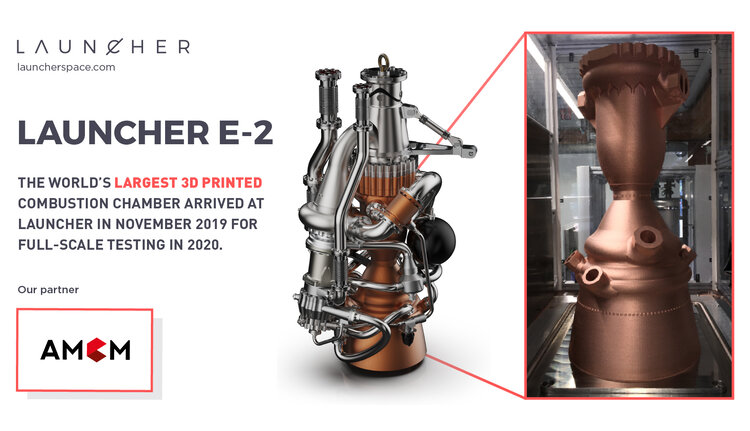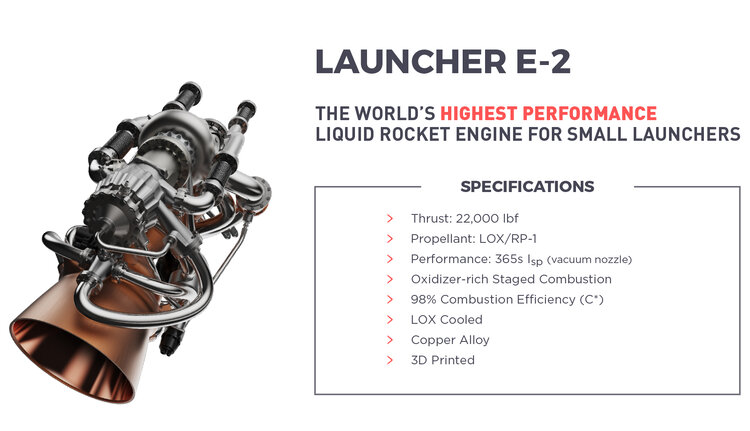Launcher, an American private aerospace company, has scheduled the first full-scale test of its E-2 rocket engine featuring a 3D printed combustion chamber. The date is set for mid-2020, and was scheduled after the company secured a $1.5 million award from the U.S. Air Force (USAF) to help further develop the engine.
Produced by AMCM, an EOS Group company that makes custom additive manufacturing machines, the component is reportedly the world’s largest liquid rocket engine combustion chamber 3D printed in a single part. Launcher initially announced development of the groundbreaking aerospace component in February 2019.

Launching into space with 3D printing
Founded in 2017 in Brooklyn, New York, Launcher is an aerospace startup seeking to create an efficient rocket solution for delivering small satellites to space.
The company believes it has found an answer with its Rocket-1 launch vehicle. Standing at 20 meters (65 feet) in length, the Rocket-1 is designed to deliver satellite payloads of up to 773 kg (1,704 lbs) to low earth orbit. Launcher claims it is the best performance launch vehicle for the small satellite market, with the highest ratio of payload to rocket mass.
As with many aerospace startups, 3D printing is playing a key role in Launcher’s outer space endeavour. Initially the company collaborated with EOS to 3D print the base for its E1 proof-of-concept engine out of copper alloy in 2018. The E-1 engine is Launcher’s first generation liquid oxygen cooled combustion chamber. The company then developed its liquid oxygen and kerosene E-2 engine in 2019, and opted to collaborate with AMCM to produce a 3D printed combustion chamber for the engine.

The E-2 engine with 3D printed combustion chamber
The E-2’s liquid rocket engine combustion chamber was 3D printed by AMCM on its M4K machine, a modified version of the EOS M400 3D printer. Made from copper alloy, the component measures at 860 mm tall (34 inches), with an exit nozzle diameter of 410 mm (16 inches). It forms a critical part of Launcher’s E-2 engine, reportedly the highest performance engine for small satellite launch vehicles.
The E-2 engine’s first full-scale test fire is scheduled for Q2 2020, with successful sub-scale tests having already been completed. A total of five E-2 engines will be used to power the Rocket-1; four for the first stage, and one for the second stage of the launch. To help accelerate the Launcher E-2 development and testing program, Launcher was awarded with $1.5M at the USAF Space and Missile Systems Center (SMC)’s Air Force Space Pitch Day on November 5 2019, a grant scheme for innovation in aerospace.

Other private aerospace firms utilizing 3D printing to reach orbit include Elon Musk’s SpaceX. The company is using 3D printed parts to support its private space exploration program. Relativity Space, a California-based aerospace company, is another example, as it is in pursuit of the world’s first entirely-3D printed rocket. The firm recently announced the successful raising of $140 million in funding, bringing the 3D printed rocket one step closer to a 2021 launch.
AMCM will be exhibiting a full-size Launcher E-2 combustion chamber mockup during Formnext 2019 in Hall 11.1, Booth C49.
Subscribe to the 3D Printing Industry newsletter for the latest news in additive manufacturing. You can also stay connected by following us on Twitter and liking us on Facebook.
Looking for a career in additive manufacturing? Visit 3D Printing Jobs for a selection of roles in the industry.
Featured image shows the E-2 rocket engine with the largest 3D printed combustion chamber. Image via Launcher.


